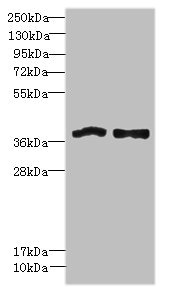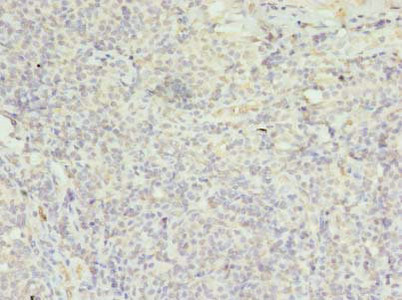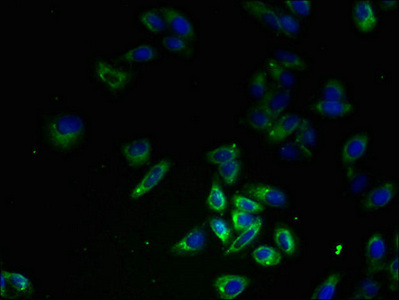FPR1 Antibody
-
货号:CSB-PA07129A0Rb
-
规格:¥440
-
促销:
-
图片:
-
Western blot
All lanes: FPR1 antibody at 6µg/ml
Lane 1: Colo320 whole cell lysate
Lane 2: HT29 whole cell lysate
Secondary
Goat polyclonal to rabbit IgG at 1/10000 dilution
Predicted band size: 39 kDa
Observed band size: 39 kDa -
Immunohistochemistry of paraffin-embedded human tonsil tissue using CSB-PA07129A0Rb at dilution of 1:100
-
Immunofluorescent analysis of HepG2 cells using CSB-PA07129A0Rb at dilution of 1:100 and Alexa Fluor 488-congugated AffiniPure Goat Anti-Rabbit IgG(H+L)
-
-
其他:
产品详情
-
产品名称:Rabbit anti-Homo sapiens (Human) FPR1 Polyclonal antibody
-
Uniprot No.:P21462
-
基因名:
-
别名:FPR1; fMet-Leu-Phe receptor; fMLP receptor; N-formyl peptide receptor; FPR; N-formylpeptide chemoattractant receptor
-
宿主:Rabbit
-
反应种属:Human
-
免疫原:Recombinant Human fMet-Leu-Phe receptor protein (306-350AA)
-
免疫原种属:Homo sapiens (Human)
-
标记方式:Non-conjugated
本页面中的产品,FPR1 Antibody (CSB-PA07129A0Rb),的标记方式是Non-conjugated。对于FPR1 Antibody,我们还提供其他标记。见下表:
-
克隆类型:Polyclonal
-
抗体亚型:IgG
-
纯化方式:>95%, Protein G purified
-
浓度:It differs from different batches. Please contact us to confirm it.
-
保存缓冲液:Preservative: 0.03% Proclin 300
Constituents: 50% Glycerol, 0.01M PBS, PH 7.4 -
产品提供形式:Liquid
-
应用范围:ELISA, WB, IHC, IF
-
推荐稀释比:
Application Recommended Dilution WB 1:500-1:2000 IHC 1:20-1:200 IF 1:50-1:200 -
Protocols:
-
储存条件:Upon receipt, store at -20°C or -80°C. Avoid repeated freeze.
-
货期:Basically, we can dispatch the products out in 1-3 working days after receiving your orders. Delivery time maybe differs from different purchasing way or location, please kindly consult your local distributors for specific delivery time.
相关产品
靶点详情
-
功能:High affinity receptor for N-formyl-methionyl peptides (fMLP), which are powerful neutrophil chemotactic factors. Binding of fMLP to the receptor stimulates intracellular calcium mobilization and superoxide anion release. This response is mediated via a G-protein that activates a phosphatidylinositol-calcium second messenger system. Receptor for TAFA4, mediates its effects on chemoattracting macrophages, promoting phagocytosis and increasing ROS release.
-
基因功能参考文献:
- Results show high expression of FPR1 in triple-negative breast cancer (TNBC) and in lymph node metastasis. This expression level was positively correlated with that of AnxA1 in primary tumors. The autocrine activation of FPR1 by AnxA1 might be a pivotal target for TNBC. PMID: 29932988
- FPR1 mRNA levels in whole blood can predict the presence of lung cancer. Using this as a reflex test for positive lung cancer screening computed tomography scans has the potential to increase the positive predictive value. PMID: 29313979
- To develop enzyme-resistant analogues, we applied here the Retro-Inverso (RI) approach, whereby the topology of the side chains is maintained by inverting the sequence of the peptide and the chirality of all residues. Molecular dynamics suggests that peptide RI-3 adopts the turn structure typical of uPAR-FPR1 antagonists PMID: 28465589
- s found that the co-expression of uPAR and FPR1 confers to A375 and M14 melanoma cells a clear-cut capability to move towards chemotactic gradients, to cross extracellular matrix and endothelial monolayers. FPR1 activity is required, as cell migration and invasion were abrogated by receptor desensitization. PMID: 29216889
- Taken together, our results suggest that intracellular FPR in naive CD4 T cells and surface FPRs in activated CD4 T cells might regulate immune responses by regulating CD4 T cell activity. PMID: 29427663
- the FPR1 downstream signaling pathways were competitively inhibited by HCH6-1. Furthermore, HCH6-1 prevented pulmonary neutrophil infiltration and edema along with alveolar damage in LPS-induced ALI in mice. Our findings suggest that HCH6-1, a FPR1 antagonist, may have potential as a new therapeutic agent for treating FPR1-involved inflammatory lung diseases PMID: 28232203
- The data demonstrate that FPR1 is involved in neuroblastoma development and could represent a therapy option for the treatment of neuroblastoma. PMID: 27432059
- FAM3D plays a role in gastrointestinal homeostasis and inflammation through its receptors FPR1 and FPR2. PMID: 26966188
- Formylated MHC class Ib binding peptides activate both human and mouse neutrophils primarily through FPR1. PMID: 27907124
- The inhibitory function of oxidant sensing by TRPM2 requires the oxidation of Cys549, which then induces TRMP2 binding to formyl peptide receptor 1 (FPR1) and subsequent FPR1 internalization and signaling inhibition PMID: 27569419
- FPR1 expression is significantly upregulated in human masticatory mucosa during wound healing PMID: 28005267
- FAM19A4 is a novel ligand of formyl peptide receptor 1. PMID: 25109685
- The s describe here the activation of isolated human blood neutrophils by TcdB and, moreover, by toxin fragments generated by limited proteolytical digestion via the FPR1 receptor. PMID: 25529763
- these results highlight the importance of FPR1 in chemotherapy-induced anticancer immune responses. PMID: 26516201
- Data suggest that formyl peptide receptor 1 (FPR1) stimulation may represent a novel therapeutic approach to counteract tumor angiogenesis. PMID: 25263443
- a pepducin designed to target FPR1 was found to hijack FPR2 and potently inhibit neutrophil functions PMID: 26071379
- the co-upregulated expression of mast cell chymase and ANXA1-FPR1 system in ectopic endometrium suggests their involvement in the development of endometriotic lesions. PMID: 25201101
- FPR1 rs78488639 interacted with CFH rs800292, HTRA1 rs11200638, and smoking, enhancing risk to exudative age-related macular degeneration and polypoidal choroidal vasculopathy . PMID: 25277308
- These results demonstrate that a necroptosis pathway, likely mediated by annexin 1 acting through the FPR1 receptor, contributes to Stevens-Johnson syndrome (SJS) and toxic epidermal necrolysis. PMID: 25031270
- A low FPR1/beta1 integrin co-localization was observed. PMID: 24466048
- cross-desensitization of CCR1 by FPR1 was associated with CCR1 phosphorylation and moderate reduction of CCR1 cell-surface expression. In contrast, CCR2 was not phosphorylated or internalized after FPR1 activation. PMID: 24778447
- FPR1 expression may be used as a novel indicator to predict outcome in gastric cancer patients after gastrectomy. PMID: 24778024
- Identification of C-terminal phosphorylation sites of N-formyl peptide receptor-1 (FPR1) in human blood neutrophils. PMID: 23873933
- The active F2Pal10 pepducin also triggered a response in cells expressing a mutated FPR2 with the third intracellular loop identical to that of FPR1. PMID: 23562731
- Our findings reveal that FPR and FPRL1 are overexpressed in primary melanoma and correlate with aggressive tumor characteristics PMID: 23147350
- UPAR, whose expression is regulated by uPA, can, in turn, regulate uPA expression through a mechanism involving its functional interaction with integrins and fMLF-Rs. PMID: 23238745
- haplotypic variation in FPR1, especially the SNP p.V101L, alters the receptor's response to cyclosporins PMID: 23373827
- The expression of the formyl peptide receptor 1 (FPR1) gene in primary human macrophages is regulated by cytokines and bacterial ligands. PMID: 23185575
- FPR1 is functionally expressed on human lens epithelial cells. PMID: 23012360
- physiological shear forces alter neutrophil activation via FP PMID: 22768936
- analysis of pyrazoles as novel FPR1 antagonists PMID: 22094028
- The expression of FPR1 in myeloid cells is developmentally regulated, and the differentiated cells are equipped for immediate response to microbial infections. PMID: 22174875
- When normotensive individuals were compared to hypertensives ones, similar FPR1 C32T genotypes and allele frequency distributions were found PMID: 21144844
- Enteric commensal bacteria induce extracellular signal-regulated kinase pathway signaling via formyl peptide receptor-dependent redox modulation of dual specific phosphatase 3 PMID: 21921027
- Using the homology modeling of the receptors and the ligand docking simulation, here we show that these calpain inhibitors could bind to the putative N-formyl-Met-Leu-Phe (fMLF) binding site on FPR and/or FPRL1. PMID: 22005393
- fMLP promotes osteoblast differentiation via the N-formyl peptide receptor 1-mediated signaling pathway in human mesenchymal stem cells from bone marrow PMID: 21372136
- This study identifies annexin A1 as part of the anti-inflammatory pattern of apoptotic cells and links the activation of FPRs to established signalling pathways triggering anti-inflammatory responses. PMID: 21254404
- This is the first study to evaluate polymorphisms of the FPR1 gene in stomach cancer to find a positive association between these polymorphisms and stomach cancer. PMID: 21216225
- These observations suggest a novel signaling role for ANXA1 in mitogen-activated proliferation of breast tumor epithelial cells that is mediated via activation of FPR1 and FPR2. PMID: 20930115
- The presence of the C(+) genotype/allele C of FPR301 together with smoking conferred a higher risk for aggressive periodontitis. PMID: 20019777
- The expression of FPR is responsible for increased motility of human glioblastoma cells and their formation of highly invasive tumours. PMID: 20197768
- A conformational study of human fMLP PMID: 11860029
- investigated the direct effect of LXA4 as well as the effect on agonist-induced biological responses using transfected HL-60 cells expressing FPR, FPRL1 or FPRL2 PMID: 12410796
- phosphorylation domains differentially regulate arrestin and agonist affinity PMID: 12424254
- Critical role of N-terminal N-glycosylation for proper folding of the formyl peptide receptor. PMID: 12565836
- Six single nucleotide polymorphisms have been identified including two located in the FPR1 second extracellular loop that are significantly associated with the periodontitis phenotype in African-American patients. PMID: 12595898
- Expression of FPRs on transformed or normal fibroblasts indicates that they are able to induce intracellular signaling events leading to fibroblast motility. PMID: 12902510
- an annexin 1 peptide can activate FPR, FPRL1, and FPRL2; results indicate that annexin 1 participates in regulating leukocyte emigration into inflamed tissue by activating and desensitizing different receptors of the FPR family. PMID: 15187149
- FPR-F110S displayed a delayed and significantly reduced ERK phosphorylation whereas FPR-FSCW nearly lost the ability to phosphorylate ERK PMID: 15195697
- FPR and FPRL1, use distinct signaling pathways in activation of human neutrophils PMID: 15625007
显示更多
收起更多
-
亚细胞定位:Cell membrane; Multi-pass membrane protein.
-
蛋白家族:G-protein coupled receptor 1 family
-
组织特异性:Neutrophils.
-
数据库链接:
HGNC: 3826
OMIM: 136537
KEGG: hsa:2357
STRING: 9606.ENSP00000302707
UniGene: Hs.753
























